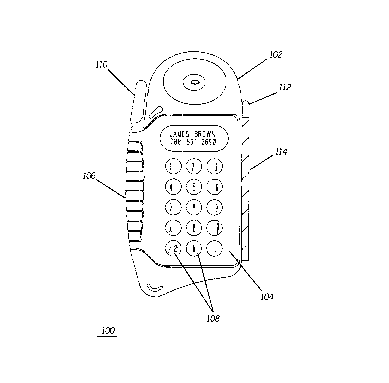Une partie des informations de ce site Web a été fournie par des sources externes. Le gouvernement du Canada n'assume aucune responsabilité concernant la précision, l'actualité ou la fiabilité des informations fournies par les sources externes. Les utilisateurs qui désirent employer cette information devraient consulter directement la source des informations. Le contenu fourni par les sources externes n'est pas assujetti aux exigences sur les langues officielles, la protection des renseignements personnels et l'accessibilité.
L'apparition de différences dans le texte et l'image des Revendications et de l'Abrégé dépend du moment auquel le document est publié. Les textes des Revendications et de l'Abrégé sont affichés :
| (12) Brevet: | (11) CA 2152861 |
|---|---|
| (54) Titre français: | DISPOSITIF DE COMMUNICATION |
| (54) Titre anglais: | COMMUNICATION DEVICE |
| Statut: | Périmé et au-delà du délai pour l’annulation |
| (51) Classification internationale des brevets (CIB): |
|
|---|---|
| (72) Inventeurs : |
|
| (73) Titulaires : |
|
| (71) Demandeurs : | |
| (74) Agent: | GOWLING WLG (CANADA) LLP |
| (74) Co-agent: | |
| (45) Délivré: | 1999-04-06 |
| (22) Date de dépôt: | 1995-06-28 |
| (41) Mise à la disponibilité du public: | 1996-01-19 |
| Requête d'examen: | 1995-06-28 |
| Licence disponible: | S.O. |
| Cédé au domaine public: | S.O. |
| (25) Langue des documents déposés: | Anglais |
| Traité de coopération en matière de brevets (PCT): | Non |
|---|
| (30) Données de priorité de la demande: | ||||||
|---|---|---|---|---|---|---|
|
Un combiné (100) offre deux modes de fonctionnement commandés par un rabat mobile (104). Le premier mode de fonctionnement, activé lorsque le rabat mobile (104) est en position fermée, permet la communication vocale bidirectionnelle. Le deuxième mode de fonctionnement, activé lorsque le rabat mobile (104) est en position ouverte, offre les fonctions d'un organiseur personnel.
A handset (100) has first and second modes of operation controlled by
a moveable flap (104). The first mode of operation provides two way voice
communication when the moveable flap (104) is in a closed position. The
second mode of operation provides a personal organizer when the flap (104)
is in a open position.
Note : Les revendications sont présentées dans la langue officielle dans laquelle elles ont été soumises.
Note : Les descriptions sont présentées dans la langue officielle dans laquelle elles ont été soumises.

2024-08-01 : Dans le cadre de la transition vers les Brevets de nouvelle génération (BNG), la base de données sur les brevets canadiens (BDBC) contient désormais un Historique d'événement plus détaillé, qui reproduit le Journal des événements de notre nouvelle solution interne.
Veuillez noter que les événements débutant par « Inactive : » se réfèrent à des événements qui ne sont plus utilisés dans notre nouvelle solution interne.
Pour une meilleure compréhension de l'état de la demande ou brevet qui figure sur cette page, la rubrique Mise en garde , et les descriptions de Brevet , Historique d'événement , Taxes périodiques et Historique des paiements devraient être consultées.
| Description | Date |
|---|---|
| Inactive : Symbole CIB 1re pos de SCB | 2022-09-10 |
| Inactive : CIB du SCB | 2022-09-10 |
| Inactive : CIB du SCB | 2022-09-10 |
| Inactive : CIB expirée | 2009-01-01 |
| Inactive : CIB de MCD | 2006-03-11 |
| Le délai pour l'annulation est expiré | 2000-06-28 |
| Lettre envoyée | 1999-06-28 |
| Accordé par délivrance | 1999-04-06 |
| Inactive : Taxe finale reçue | 1998-12-29 |
| Préoctroi | 1998-12-29 |
| Un avis d'acceptation est envoyé | 1998-10-15 |
| Lettre envoyée | 1998-10-15 |
| Un avis d'acceptation est envoyé | 1998-10-15 |
| Inactive : Renseign. sur l'état - Complets dès date d'ent. journ. | 1998-10-08 |
| Inactive : Dem. traitée sur TS dès date d'ent. journal | 1998-10-08 |
| Inactive : Approuvée aux fins d'acceptation (AFA) | 1998-09-15 |
| Demande publiée (accessible au public) | 1996-01-19 |
| Toutes les exigences pour l'examen - jugée conforme | 1995-06-28 |
| Exigences pour une requête d'examen - jugée conforme | 1995-06-28 |
Il n'y a pas d'historique d'abandonnement
Le dernier paiement a été reçu le
Avis : Si le paiement en totalité n'a pas été reçu au plus tard à la date indiquée, une taxe supplémentaire peut être imposée, soit une des taxes suivantes :
Veuillez vous référer à la page web des taxes sur les brevets de l'OPIC pour voir tous les montants actuels des taxes.
| Type de taxes | Anniversaire | Échéance | Date payée |
|---|---|---|---|
| TM (demande, 3e anniv.) - générale | 03 | 1998-06-29 | 1998-05-01 |
| Taxe finale - générale | 1998-12-29 | ||
| TM (demande, 2e anniv.) - générale | 02 | 1997-06-30 |
Les titulaires actuels et antérieures au dossier sont affichés en ordre alphabétique.
| Titulaires actuels au dossier |
|---|
| MOTOROLA, INC. |
| Titulaires antérieures au dossier |
|---|
| FRANK M. TYNESKI |
| MAC WILLIAM JR. BRANAN |